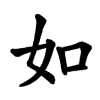Definify.com
Definition 2025
個
個
| ||||||
|---|---|---|---|---|---|---|
Translingual
| Stroke order | |||
|---|---|---|---|

| |||
Han character
個 (radical 9 人+8, 10 strokes, cangjie input 人田十口 (OWJR), four-corner 26200, composition ⿰亻固)
Derived characters
References
- KangXi: page 107, character 17
- Dai Kanwa Jiten: character 758
- Dae Jaweon: page 228, character 2
- Hanyu Da Zidian: volume 1, page 178, character 3
- Unihan data for U+500B
Chinese
| trad. | 個/箇 | |
|---|---|---|
| simp. | 个 | |
Glyph origin
| Characters in the same phonetic series (古) (Zhengzhang, 2003) | |
|---|---|
| Old Chinese | |
| 箇 | *kaːls |
| 個 | *kaːls |
| 居 | *kɯ, *kas |
| 橭 | *kaː, *kʰaː |
| 嫴 | *kaː |
| 姑 | *kaː |
| 辜 | *kaː |
| 酤 | *kaː, *kaːs, *ɡaːʔ |
| 蛄 | *kaː |
| 鴣 | *kaː |
| 沽 | *kaː, *kaːʔ, *kaːs |
| 盬 | *kaː, *kaːʔ |
| 古 | *kaːʔ |
| 罟 | *kaːʔ |
| 估 | *kaːʔ |
| 鈷 | *kaːʔ |
| 詁 | *kaːʔ |
| 牯 | *kaːʔ |
| 故 | *kaːs |
| 固 | *kaːs |
| 稒 | *kaːɡs |
| 痼 | *kaːɡs |
| 錮 | *kaːɡs |
| 鯝 | *kaːɡs |
| 棝 | *kaːɡs |
| 凅 | *kaːɡs |
| 枯 | *kʰaː |
| 軲 | *kʰaː |
| 跍 | *kʰaː |
| 骷 | *kʰaː |
| 苦 | *kʰaːʔ, *kʰaːs |
| 葫 | *qʰaː, *ɡaː |
| 餬 | *ɡaː |
| 瑚 | *ɡaː |
| 湖 | *ɡaː |
| 鶘 | *ɡaː |
| 猢 | *ɡaː |
| 醐 | *ɡaː |
| 糊 | *ɡaː |
| 箶 | *ɡaː |
| 蝴 | *ɡaː |
| 胡 | *ɡaː |
| 瓳 | *ɡaː |
| 怙 | *ɡaːʔ |
| 祜 | *ɡaːʔ |
| 岵 | *ɡaːʔ |
| 婟 | *ɡaːʔ, *ɡaːɡs |
| 楛 | *ɡaːʔ |
| 据 | *ka |
| 裾 | *ka |
| 琚 | *ka |
| 椐 | *ka, *kas, *kʰa |
| 鶋 | *ka |
| 蜛 | *ka |
| 崌 | *ka |
| 涺 | *ka |
| 腒 | *ka, *ɡa |
| 鋸 | *kas |
| 倨 | *kas |
| 踞 | *kas |
| 涸 | *ɡaːɡ |
Phono-semantic compound (形聲, OC *kaːls) : semantic 亻 + phonetic 固 (OC *kaːs).
Etymology
The semantics may have developed along the grammaticalisation process "bamboo stalk" (箇) > "piece, item" > "classifier for every category of noun" > "possessive particle, generic particle". If so, it would then possibly be cognate with 竿 (OC *kaːn, “bamboo, rod”). Compare Tibetan མཁར་བ (mkhar ba), འཁར་བ ('khar ba, “walking stick, staff”) and Thai ก้าน (gâan, “stem, stalk”).
Pronunciation
- Mandarin
- Cantonese (Jyutping): go3
- Gan (Wiktionary): go4
- Hakka (Sixian, PFS): ke / kai
- Jin (Wiktionary): ge3
- Min Nan
- Wu (Wiktionary): geq (T5); hheq (T5); eq (T4); ku (T2)
- Xiang (Wiktionary): go4
- Mandarin
- (Standard Chinese, Beijing)+
- Pinyin:
- Zhuyin: ㄍㄜˋ
- Wade-Giles: ko4
- Gwoyeu Romatzyh: geh
- IPA (key): /kɤ⁵¹/
-

- (Standard Chinese, Beijing)+
- Pinyin:
- Zhuyin: ㄍㄜ˙
- Wade-Giles: ko5
- Gwoyeu Romatzyh: .ge
- IPA (key): /g̊ə/
- (Standard Chinese, Beijing)+
- Cantonese
- (Standard Cantonese, Guangzhou)+
- Jyutping: go3
- Yale: go
- Cantonese Pinyin: go3
- IPA (key): /kɔː³³/
- (Standard Cantonese, Guangzhou)+
- Gan
- Hakka
- (Sixian, incl. Miaoli and Meinong)
- Pha̍k-fa-sṳ: ke / kai
- Hakka Romanization System: ge / gai
- Hagfa Pinyim: ge4 / gai4
- IPA: /ke⁵⁵/, /ka̯i⁵⁵/
- (Sixian, incl. Miaoli and Meinong)
- Jin
- Min Nan
- (Hokkien)
- Pe̍h-ōe-jī: kò / ê
- Tâi-lô: kò / ê
- Phofsit Daibuun: koix, ee
- IPA (Xiamen): /kɤ²¹/, /e²⁴/
- IPA (Quanzhou): /kɤ⁴¹/, /e²⁴/
- IPA (Zhangzhou): /kɤ²¹/, /e¹³/
- IPA (Taipei): /ko¹¹/, /e²⁴/
- IPA (Kaohsiung): /kɤ²¹/, /e²³/
- Note: kò - literary; ê - classifier, possessive particle.
- (Teochew)
- Peng'im: go6 / gai5 / gai7
- Pe̍h-ōe-jī-like: kŏ / kâi / kāi
- IPA (key): /ko³⁵/, /kai⁵⁵/, /kai¹¹/
- Note: go6 - literary; gai5 - classifier; gai7 - possessive particle.
- (Hokkien)
- Wu
- (Shanghainese)
- Wiktionary: geq (T5); hheq (T5); eq (T4); ku (T2)
- IPA (key): /g̊əʔ¹²/, /ɦəʔ¹²/, /əʔ⁵⁵/, /kv̩ʷ³⁴/
- Note: As classifier or particle: 5geq ~ 5hheq ~ 4eq; literary: 2ku.
- (Shanghainese)
- Xiang
| Rime | |
|---|---|
| Character | 個 |
| Reading # | 1/1 |
| Initial (聲) | 見 (28) |
| Final (韻) | 歌 (94) |
| Tone (調) | Departing (H) |
| Openness (開合) | Open |
| Division (等) | I |
| Fanqie | 古賀切 |
| Reconstructions | |
| Zhengzhang Shangfang |
/kɑH/ |
| Pan Wuyun |
/kɑH/ |
| Shao Rongfen |
/kɑH/ |
| Edwin Pulleyblank |
/kaH/ |
| Li Rong |
/kɑH/ |
| Wang Li |
/kɑH/ |
| Bernard Karlgren |
/kɑH/ |
| Expected Mandarin Reflex |
gè |
| Baxter-Sagart system 1.1 (2014) | |
|---|---|
| Character | 個 |
| Reading # | 1/1 |
| Modern Beijing (Pinyin) |
gè |
| Middle Chinese |
‹ kaH › |
| Old Chinese |
/*kˤa[r]-s/ |
| English | piece, item |
Notes for Old Chinese notations in the Baxter-Sagart system: * Parentheses "()" indicate uncertain presence; | |
| Zhengzhang system (2003) | |
|---|---|
| Character | 個 |
| Reading # | 1/1 |
| No. | 4208 |
| Phonetic component |
古 |
| Rime group |
歌 |
| Rime subdivision |
1 |
| Corresponding MC rime |
箇 |
| Old Chinese |
/*kaːls/ |
| Notes | 見儀禮鄭注 |
Definitions
個
- piece; item; individual
- size; height
- separate; respective; separately; individually
- single; alone
- (dialectal) one
- The generic classifier. Used with nouns lacking specific classifiers.
- Alternative classifier, for nouns having specific classifiers. Often colloquial and regional. Usage varies greatly between different topolects.
- (Mandarin, colloquial) Particle, placed between a verb and numbers, showing that the following numbers are approximate, not accurate.
-
- 他一下跑個兩三公里都不在話下。 [MSC, trad.]
- 他一下跑个两三公里都不在话下。 [MSC, simp.]
- Tā yīxià pǎo ge liǎng sān gōnglǐ dōu bùzàihuàxià. [Pinyin]
- Running two or three kilometers in one go is a piece of cake for him.
-
- 他們倆就差個一兩歲。 [MSC, trad.]
- 他们俩就差个一两岁。 [MSC, simp.]
- Tāmen liǎ jiù chà ge yī liǎng suì. [Pinyin]
- The age difference between them is only about one or two years.
-
- (Mandarin, colloquial) Particle, placed between a verb and its object or complement, adding a sense of ease, swiftness and one-offness to the action.
-
- 吃個飯,洗個澡,休息休息 [MSC, trad.]
- 吃个饭,洗个澡,休息休息 [MSC, simp.]
- chī ge fàn, xǐ ge zǎo, xiūxi xiūxi [Pinyin]
- have some food, have a shower and have some rest
-
- 我們昨天見了個面,聊了聊近況。 [MSC, trad.]
- 我们昨天见了个面,聊了聊近况。 [MSC, simp.]
- Wǒmen zuótiān jiàn le ge miàn, liáo le liáo jìnkuàng. [Pinyin]
- We met yesterday, and chatted about how we've been recently.
-
- (Mandarin, colloquial) Particle used after 些 (xiē).
- (dialectal Mandarin) Particle used in some time-related words.
- (obsolete, Wu, Xiang, Gan, dialectal Cantonese, dialectal Min) (= 搿) this; that
- (Cantonese, Wu) Word-initial particle, serving as the definite article.
- (Cantonese, Wu, Teochew) Possessive particle. Equivalent to Mandarin 的 (de).
- (dialectal) Sentence-final declarative, affirmative, or prohibitive particle. Equivalent to Mandarin 的 (de), 了 (le).
Compounds
|
|
|
Descendants
Others:
- Vietnamese: cái
Japanese
Kanji
Readings
Counter
- item, article, thing
- あの枝に桜ん坊が十二個だけあります。
- Ano eda ni sakuranbo ga jūni-ko dake arimasu.
- There are only twelve cherries on that branch.
- あの枝に桜ん坊が十二個だけあります。
Usage notes
This is the most generic counter in Japanese. It can be used to count just about anything.
Vietnamese
Han character
- This term needs a translation to English. Please help out and add a translation, then remove the text
{{rfdef}}.